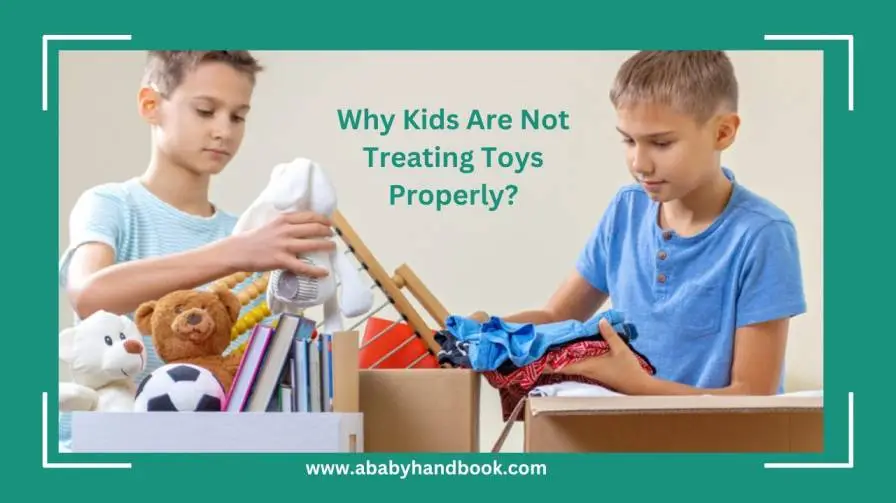Why Kids Are Not Treating Toys Properly? Plenty of reasons to adore toys. They make our kids happy and can encourage creativity and education. But even with their vibrant packaging and gift-giving appeal, some toys might pose a risk to kids due to their hidden dangers. Tens of thousands of injuries are thought to be caused by toys every year, according to the U.S. Consumer Product Safety Commission. With the right knowledge and prudence, many of these injuries can be avoided.
If you're a parent reading this, you undoubtedly want to take every precaution to keep your child safe while they're having fun. You may learn how to keep your kids safe and what to look out for while buying toys for them in this blog post.
Understanding Children's Behavior Towards Toys

Toy organization has numerous advantages for both kids and adults, but decluttering is easier said than done.
A quieter, less stressful atmosphere with fewer, well-organized toys helps kids avoid overstimulation and improves their ability to control their behavior and why kids are not treating toys properly.
Read Also: Child Development: How Does Hierachy Of Needs Relate To Child Development?
11 Reasons Kids Misuse Their Toys 2025
Typical Toy Risks
Children should be able to safely play with toys. Toys should be inspected for potential hazards before being given to children. These are the risks you should be aware of.
Items that pose a risk of choking
Be mindful of potential choking hazards in toys! A toddler who puts objects in his mouth while learning to explore his surroundings could choke on any small object. A lot of toys have tiny parts that could be eaten or restrict a child's airway if they breathe them in. Simple home objects may also be used at other occasions. Coins, bottle caps, marbles, deflated balloons, buttons and beads off garments, paper clips, sewing needles, and pins are a few examples. Small objects should be kept out of their reach to prevent these risks.
Another crucial factor to take into account is the toy's size. Younger children are more at risk from smaller toys because objects that fit completely in their mouths can quickly obstruct their narrower airways. Toys that are less than 1 ½ inches wide, 2 inches long, and 1 inch thick (4 cm x 5 cm x 2 cm) should not be given to children younger than three.
Sharp and Pointed Edges
Children younger than three years old are at risk from toys with sharp edges and pointed points. The reason for this is that young children are unable to comprehend that these sharp things are not toys. They might attempt to eat them, pierce their noses or ears, or toss them at a different child. If broken or used improperly, even seemingly safe objects—like wooden blocks—can result in wounds and abrasions. Examine every item for sharp edges, and replace it right away.
Toys That May Suffocate and Strangulate Children

Infants and very young children may be at risk from long cables and strings. These have the potential to strangle a baby if they wound up looped around their neck. Toys with dangling ropes, loops, ribbons, or strings should not be left in playpens or cribs where kids could tangle. Additionally, keep plastic bags out of reach because they can suffocate people. As soon as your child's toys arrive, dispose of the plastic wrapping they came in.
Toys that run on batteries or have loose magnets
Battery-operated toys should have screwed-on battery covers to keep kids from taking the batteries out. Internal bleeding, choking, and chemical burns can result from lithium batteries, battery fluids, and magnets.
Must Read: Everything You Need To Know About Baby Doll NYT Crossword
Toys that Make Loud Sounds
Your child's hearing may be harmed by the loud or harsh noises made by many toys. Many toys emit louder sounds than what is advised for children, even though the majority of products are labeled with warnings against loud noises. For instance, at close range, toy firearms may sound like real guns. Check the toys' decibel level or volume when you're shopping for them.
Lead Paint and Hazardous Substances
Chewing on toys that contain lead can cause lead poisoning in children. A youngster exposed to lead poisoning may experience long-term effects on their behavior, learning capacity, and overall development. Certain toys and jewelry, particularly those manufactured abroad and vintage toys, may contain lead in their paint, metal, and plastic parts.
Make Your Child's Play Safe by Using These Pointers

Although there is no way to ensure that a toy will be risk-free, the goal is to conduct your research so you can decide what's best for your family.
You May Also Like: My Boy Only Breaks His Favorite Toys Child Development
Purchase Age-Related Playthings
Developmentally suitable toys should be selected using age-appropriate labeling. For instance, toys with small parts or choking hazards shouldn't be left unattended by toddlers under three. Using a small-object choking tester is a great technique to find out if a toy is big enough. The words "non-toxic" and "ASTM D-4236" must be present on the packaging of crayons and other art supplies. It indicates that they have undergone safety testing by the American Society for Testing and Materials.
Close supervision is the best.
When children are playing with toys, it is advisable to keep an eye on them whenever feasible. You will need to take even more care to ensure that your child is supervised and protected from accidents and injuries if they have special needs, such as a risk of injury from falling down stairs or rushing into the street.
Toy Maintenance and Storage
Examine toys frequently for indications of wear and tear. A damaged toy should be fixed or thrown out right away. Additionally, to prevent trips and falls, tell kids to put their toys away after playing. You also need to inspect the storage areas! To prevent it from falling on a child, pick a toy chest that why kids are not treating toys properly.
Avoid Using Specific Toy Types
Avoid purchasing toys that contain projectiles that could injure your eyes, such as rockets or missiles. Also, stay away from toys that look like actual firearms. A real weapon could be mistaken for a toy knife or pistol by certain kids. Sincetoy swords and bows can injure both children and adults, they are never appropriate toys for toddlers.
Additionally, you should avoid buying used toys from thrift shops and internet auctions if you want to ensure that your child will only utilize safe toys. It's also not a good idea to use old hand-me-down toys because you can't be sure that the material is safe and non-toxic.
FAQs
Why is it bad for kids to have too many toys?

A child may suffer from having too many toys, according to experts. When there are too many toys available, toddlers may become overwhelmed and find it difficult to concentrate on just one activity. Youngsters six and up may discover that an abundance of toys gives them the impression that everything is interchangeable and that toys are worthless.
Why do toddlers get frustrated with toys?
Of course, certain toys can be frustrating. A baby's innate motivation to overcome challenges is reflected in their battle to understand how a toy works, which is essential for success in all forms of learning later on.
What if my toddler doesn't play with toys correctly?
Take away the toys right away if your child keeps playing with them in an unsuitable way, such as throwing them, hitting other people with them, or attempting to break them. Tell your kid that this isn't the proper way to play with the toys.
Is it typical for children to ruin toys?
Even if this behavior is typical, it nevertheless irritates me greatly. Any toys that are easily and permanently breakable should be taken away if your child is acting rough or wants to break them during a phase.








